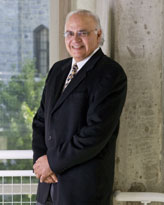CAC’s Collaboration with BFTP Serves as International Model
Since 1992, the College of Engineering’s Center for Advanced Communications (CAC) and the Ben Franklin Technology Partners of Southeastern Pennsylvania (BFTP/SEP) have enjoyed an extraordinarily successful partnership that has translated into regional economic growth and expanded research opportunities for Villanova faculty and students. How that partnership works, why it is successful, and why it could be a suitable model in the Middle East was the subject of a paper coauthored by Dr. Moeness Amin, CAC’s Director, and Richard Thompson, PE, EE ’64, Manager of BFTP/SEP’s Technology Commercialization Group. Dr. Amin was invited to present this paper at the Association of Egyptian American Scholars’ 35th annual conference, held in Cairo in December 2008.
The synergistic partnership actually involves three players—academia, industry, and government. By bringing their particular strengths to the relationship, the three produce outcomes that benefit everyone. In this case, the CAC has tremendous knowledge, facilities, and human capital. Technology-based startups and small businesses have innovative ideas but often lack the resources to carry projects to the marketplace. Bridging the two is BFTP. This state-funded, nonprofit, economic development network has a commercialization program that links universities with companies to solve sophisticated technical problems through micro grants and in-kind support.
This successful relationship has created regional jobs; strengthened businesses; and enabled the CAC to undertake research in emerging technologies, involve more students in sponsored research on real-world problems, and obtain substantial government funding. “The success is rooted in the ability of the CAC to balance its academic needs with the valuable service it provides to local industry and government partners,” Thompson said.
According to Dr. Amin, it is this balance that makes the model compelling. “The knowledge and facilities housed in universities should be used not only for education and research but for helping companies with technology transfer, which leads to economic growth.”


